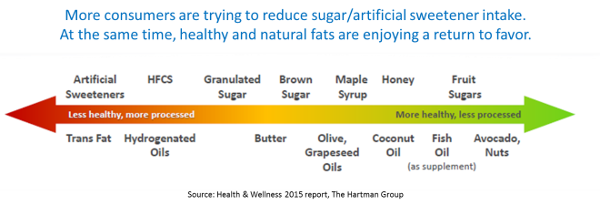How Sweet It Is: Natural/Organic Candy Fertile Ground for Growth?
 Consumers still crave sweet treats, and an increase in natural/organic candy brands is helping consumers feel more virtuous about giving in to temptation. The Hartman Group’s Health and Wellness 2015 report reveals that consumers don’t believe avoiding treats altogether is necessary for maintaining a healthy diet.
Consumers still crave sweet treats, and an increase in natural/organic candy brands is helping consumers feel more virtuous about giving in to temptation. The Hartman Group’s Health and Wellness 2015 report reveals that consumers don’t believe avoiding treats altogether is necessary for maintaining a healthy diet.
Our research found that consumers believe that the idea of maintaining balance in their diets helps justify indulgences and comforting treats. Consumers said they believe denying treats can lead to increased desire and loss of control, making it ultimately healthier to enjoy the pleasure and comfort that treats provide in moderation than to risk overdoing it later.
Yet while consumers aren’t averse to enjoying the occasional treat, they are mindful about the foods they are choosing to satisfy their cravings. The Health & Wellness 2015 report shows a big leap in the number of consumers who say they are avoiding refined sugar and artificial sweeteners, and are opting instead for treats flavored with brown sugar, maple sugar, honey and fruit sugars. At the same time, healthy and natural fats are enjoying a return to favor—good news for chocolate lovers.

The Health & Wellness report also points out that 42 percent of consumers are trying to avoid/reduce artificial colors/dyes, 40 percent are avoiding/reducing artificial flavors and another 37 percent say they are avoiding or reducing artificial preservatives.
These trends have created a fertile market for organic/natural candy products. Small manufacturers have been answering the needs of vegan consumers for some time with organic chocolate and gummy candies formulated without a gelatin base. Specialty natural and organic candy brands have become go-to brands for consumers craving high-quality, high-cacao content chocolate. These organic chocolate brands stand out due to the health-halo benefit from dark chocolate and their messages about pure ingredients, sustainability and high standards for organic and fair trade.
Consumers have been willing to pay more for special treats they believe have additional benefits. One respondent in our research described routinely indulging in organic chocolate because “it’s rich and has more antioxidants because it’s dark.”
More sophisticated natural and organic candy products have continued to enter the market and are attracting a wider range of new consumers. Adam Morris, grocery manager at Ithaca, New York-based GreenStar Natural Foods Market, said the store entered the natural/organic category ten years ago with chocolate bars and now has a sizable candy sectinon with over a dozen manufacturers represented. The store isn’t offering just organic dark chocolate and gummies but organic versions of candies that are often found on traditional mass market store shelves.
“The new candy shoppers are looking for a cleaner version of the candies that they are used to,” said Morris. “There’s been an explosion of ‘clean’ versions of classic candy brands, such as Justin’s Organic Peanut Butter Cups and TruJoy Sweets’ Organic Original Fruit Chews, which resemble Starburst candies. These companies are creating products that mainstream consumers want.”
TruJoy Sweets’ Organic Candy Canes are sold at Wegmans, Publix and a number of other traditional supermarket chains. YumEarth, which Morris cited as a strong brand at GreenStar, has expanded its distribution to mainstream retail outlets such as Costco, Target, Kroger, TJ Maxx and Walgreens. The company recently added a Gluten-free Licorice to its lineup of products that includes YumEarth Organic Lollipops, YumEarth Sour Beans, YumEarth Gummy Bears and YumEarth Fruit Snacks.
“We’ve had a great reception for our new YumEarth Gluten-free Licorice, which leads us to believe they will soon top our best sellers list,” said Rob Wunder, co-founder of YumEarth. “We see growth potential in all candy categories, with a tremendous focus on fruit snacks and lollipops.”
Creative products, such as a gummy-filled hollow chocolate Santa from Sjaaks, Surf Sweets’ gummies in holiday mini-bags and Theo Chocolate’s Peanut Butter Cups, Coconut Bites and small chocolate bars in novel flavors, continue to attract new consumers to the natural/organic category and capture the interest of mass market retailers.
Larger, traditional candy manufacturers have taken notice. Earlier this year, Nestlé USA said it will remove all flavors perceived as artificial and Food and Drug Administration-certified colors from all of its chocolate candy products by the end of 2015.
The Hershey Company followed with an announcement that the company pledged to simplify ingredients, be more transparent about sourcing, manufacturing and labeling and source 100 percent certified and sustainable cocoa and certified sustainable and traceable palm oil. Hershey said that by the end of 2015 its chocolate bars and kisses will no longer contain GMO sugar, soy lecithin or other artificial ingredients. So far, Mars Chocolate North America has limited its activity in the organic/natural space to the nationwide launch of its goodnessknows snack squares in spring 2015.
Will innovative small companies become an attractive acquisition target for larger companies looking for a way to raise their profile in the growing organic and natural segment or will they tinker with their own formulations to reflect consumer preferences? It will be an interesting category to watch in 2016.
More in Hartbeat Exec: Market Dynamics of the New Premium
